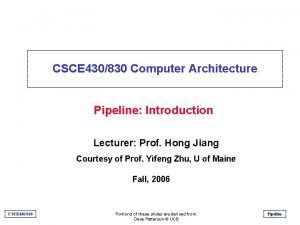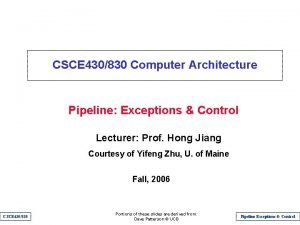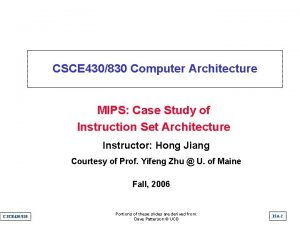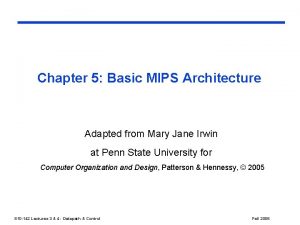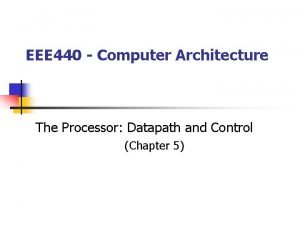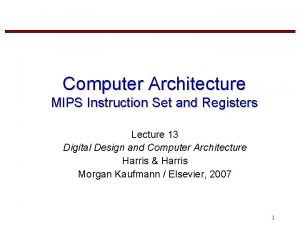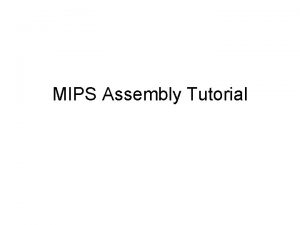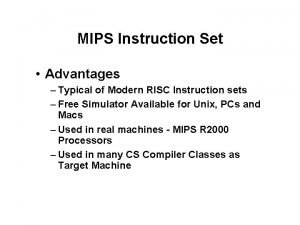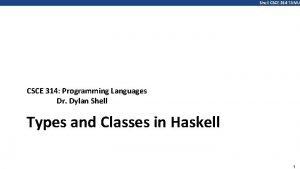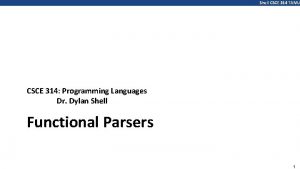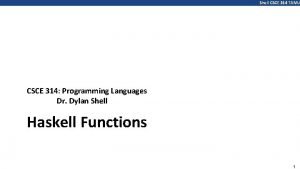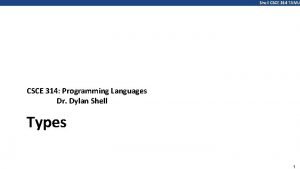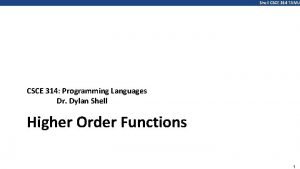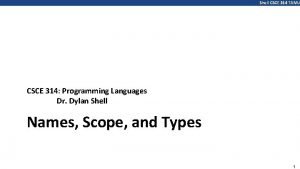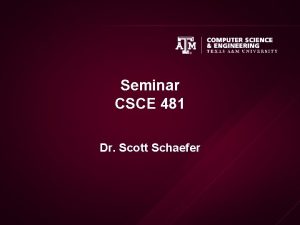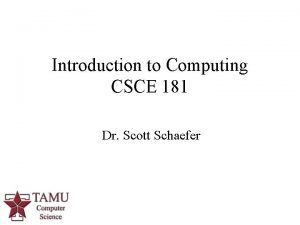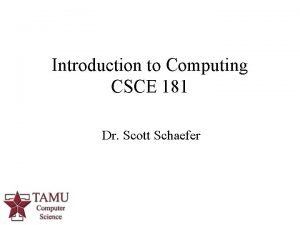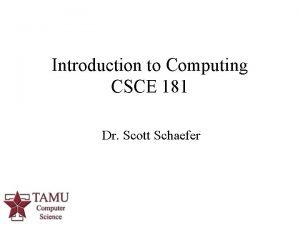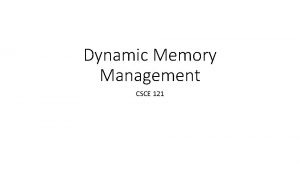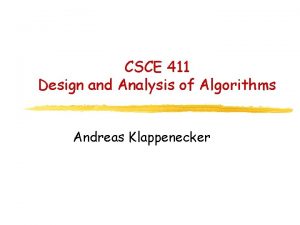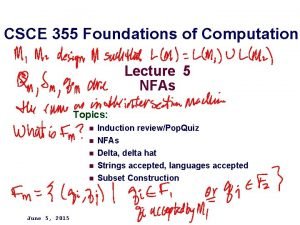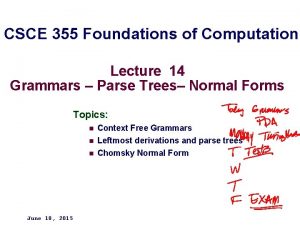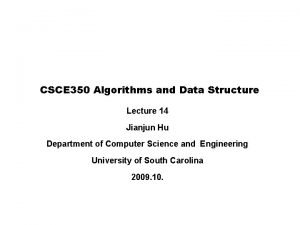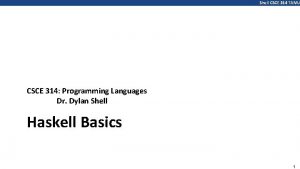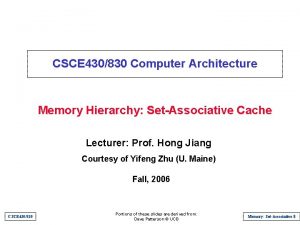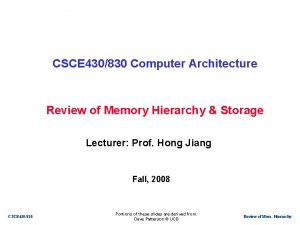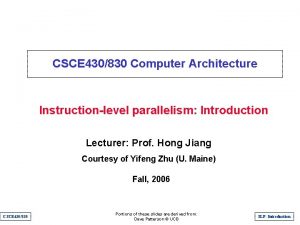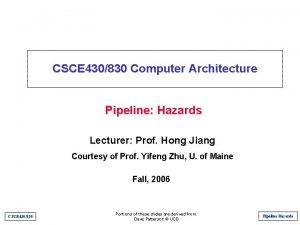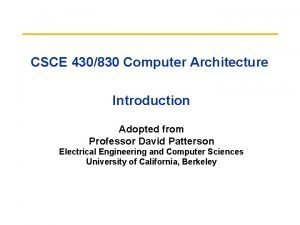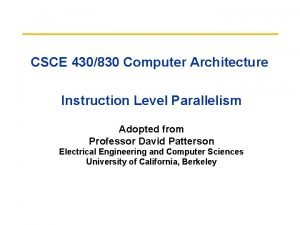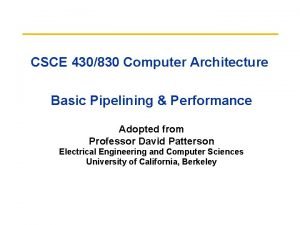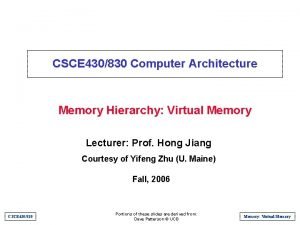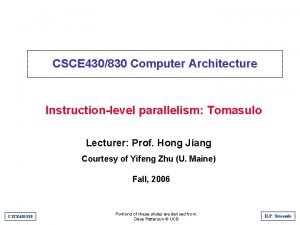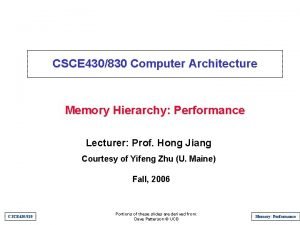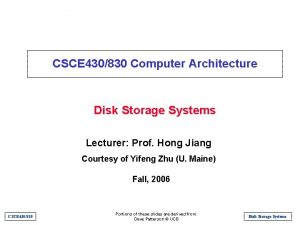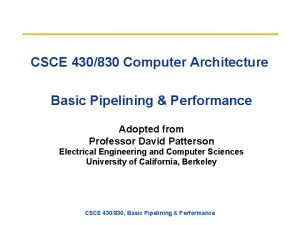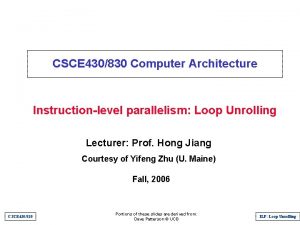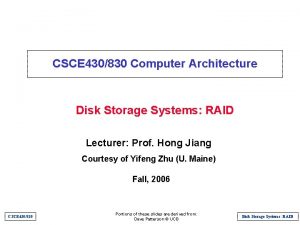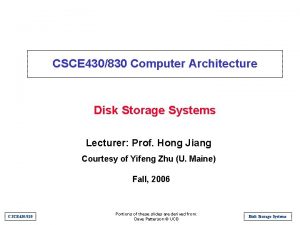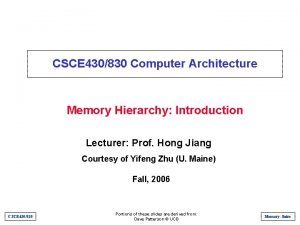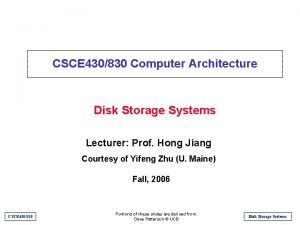CSCE 430830 Computer Architecture MIPS Case Study of



































- Slides: 35

CSCE 430/830 Computer Architecture MIPS: Case Study of Instruction Set Architecture Instructor: Hong Jiang Courtesy of Prof. Yifeng Zhu @ U. of Maine Fall, 2006 CSCE 430/830 Portions of these slides are derived from: Dave Patterson © UCB ISA-2

Outline - Instruction Sets • Instruction Set Overview • MIPS Instruction Set – Overview – Registers and Memory – MIPS Instructions CSCE 430/830 ISA-2

MIPS • MIPS: Microprocessor without Interlocked Pipeline Stages • We’ll be working with the MIPS instruction set architecture – similar to other architectures developed since the 1980's – Almost 100 million MIPS processors manufactured in 2002 – used by NEC, Nintendo, Cisco, Silicon Graphics, Sony, … CSCE 430/830 ISA-2

MIPS Design Principles 1. Simplicity Favors Regularity • • Keep all instructions a single size Always require three register operands in arithmetic instructions 2. Smaller is Faster • Has only 32 registers rater than many more 3. Good Design Makes Good Compromises • Comprise between providing larger addresses and constants instruction and keeping instruction the same length 4. Make the Common Case Fast • • CSCE 430/830 PC-relative addressing for conditional branches Immediate addressing for constant operands ISA-2

Outline - Instruction Sets • Instruction Set Overview • MIPS Instruction Set – Overview – Registers and Memory – MIPS Instructions CSCE 430/830 ISA-2

MIPS Registers and Memory 32 bits R 0 R 1 R 2 R 30 R 31 32 General Purpose Registers PC = 0 x 0000001 C 0 x 00000004 0 x 00000008 0 x 0000000 C 0 x 00000010 0 x 00000014 0 x 00000018 0 x 0000001 C 0 xfffffff 4 0 xfffffffc Registers Memory 4 GB Max (Typically 64 MB-1 GB) CSCE 430/830 ISA-2

MIPS Registers and Usage Each register can be referred to by number or name. CSCE 430/830 ISA-2

More about MIPS Memory Organization • Two views of memory: – 232 bytes with addresses 0, 1, 2, …, 232 -1 – 230 4 -byte words* with addresses 0, 4, 8, …, 232 -4 • Both views use byte addresses Not all architectures require this • Word address must be multiple of 4 (aligned) 8 bits 0 x 00000001 0 x 00000002 0 x 00000003 32 bits 0 x 00000004 0 x 00000008 0 x 0000000 C 0 1 2 3 *Word sizes vary in other architectures CSCE 430/830 ISA-2

Outline - Instruction Sets • Instruction Set Overview • MIPS Instruction Set – Overview – Registers and Memory – MIPS Instructions • Summary CSCE 430/830 ISA-2

MIPS Instructions • All instructions exactly 32 bits wide • Different formats for different purposes • Similarities in formats ease implementation 31 31 31 CSCE 430/830 6 bits 5 bits op rs rt rd 6 bits 5 bits 16 bits op rs rt offset 6 bits shamt funct 6 bits 26 bits op address 0 0 R-Format I-Format J-Format 0 ISA-2

MIPS Instruction Types • Arithmetic & Logical - manipulate data in registers add $s 1, $s 2, $s 3 $s 1 = $s 2 + $s 3 or $s 3, $s 4, $s 5 $s 3 = $s 4 OR $s 5 • Data Transfer - move register data to/from memory lw $s 1, 100($s 2) $s 1 = Memory[$s 2 + 100] sw $s 1, 100($s 2) Memory[$s 2 + 100] = $s 1 • Branch - alter program flow beq $s 1, $s 2, 25 if ($s 1==$s 1) PC = PC + 4*25 CSCE 430/830 ISA-2

MIPS Arithmetic & Logical Instructions • Instruction usage (assembly) add dest, src 1, src 2 sub dest, src 1, src 2 and dest, src 1, src 2 dest=src 1 + src 2 dest=src 1 - src 2 dest=src 1 AND src 2 • Instruction characteristics – Always 3 operands: destination + 2 sources – Operand order is fixed – Operands are always general purpose registers • Design Principles: – Design Principle 1: Simplicity favors regularity – Design Principle 2: Smaller is faster CSCE 430/830 ISA-2

Arithmetic & Logical Instructions Binary Representation 31 6 bits 5 bits op rs rt rd 5 bits 6 bits shamt funct 0 • Used for arithmetic, logical, shift instructions – – – op: Basic operation of the instruction (opcode) rs: first register source operand rt: second register source operand rd: register destination operand shamt: shift amount (more about this later) funct: function - specific type of operation • Also called “R-Format” or “R-Type” Instructions CSCE 430/830 ISA-2

Arithmetic & Logical Instructions Binary Representation Example • Machine language for add $8, $17, $18 • See reference card for op, funct values 31 6 bits 5 bits op rs rt rd 0 17 18 8 5 bits 6 bits shamt funct 0 32 000000 10001 10010 01000 00000 100000 CSCE 430/830 0 Decimal Binary ISA-2

MIPS Data Transfer Instructions • Transfer data between registers and memory • Instruction format (assembly) lw $dest, offset($addr) sw $src, offset($addr) load word store word • Uses: – Accessing a variable in main memory – Accessing an array element CSCE 430/830 ISA-2

Example - Loading a Simple Variable 8 R 0=0 (constant) R 1 R 2=0 x 10 R 3 R 4 R 5 =R 5 629310 + 0 x 00 0 x 04 0 x 08 0 x 0 c 0 x 10 0 x 14 0 x 18 0 x 1 c Variable X Variable Y Variable Z = 692310 R 31 Registers lw R 5, 8(R 2) CSCE 430/830 Memory ISA-2

Data Transfer Example - Array Variable 12=0 xc R 0=0 (constant) R 1 R 2=0 x 08 R 3 R 4 R 5=105 + Base Address 0 x 00 0 x 04 0 x 08 0 x 0 c 0 x 10 0 x 14 0 x 18 0 x 1 c a[0] a[1] a[2] a[3]=105 a[3] a[4] R 30 R 31 Registers C Program: Assembly: CSCE 430/830 int a[5]; a[3] = z; sw $5, 12($2) scaled offset Memory ISA-2

Data Transfer Instructions Binary Representation 6 bits 5 bits 16 bits op rs rt offset • Used for load, store instructions – – op: Basic operation of the instruction (opcode) Address rs: first register source operand rt: second register source operand offset: 16 -bit signed address offset (-32, 768 to +32, 767) • Also called “I-Format” or “I-Type” instructions CSCE 430/830 ISA-2

I-Format vs. R-Format Instructions • Compare with R-Format 6 bits 5 bits op rs rt rd 6 bits 5 bits 16 bits op rs rt offset 6 bits shamt funct R-Format I-Format Note similarity! CSCE 430/830 ISA-2

I-Format Example • Machine language for lw $9, 1200($8) == lw $t 1, 1200($t 0) 31 6 bits 5 bits 16 bits op rs rt offset 35 8 9 1200 100011 01000 01001 CSCE 430/830 0000010010110000 0 Decimal Binary ISA-2

MIPS Conditional Branch Instructions • Conditional branches allow decision making beq R 1, R 2, LABEL bne R 3, R 4, LABEL • Example C Code L 1: Assembly L 1: CSCE 430/830 if R 1==R 2 goto LABEL if R 3!=R 4 goto LABEL if (i==j) goto L 1; f = g + h; f = f - i; beq $s 3, $s 4, L 1 add $s 0, $s 1, $s 2 sub $s 0, $s 3 ISA-2

Example: Compiling C if-then-else • Example C Code if (i==j) f = g + h; else f = g - h; Assembly bne $s 3, $s 4, Else add $s 0, $s 1, $s 2 j Exit; # new: unconditional jump sub $s 0, $s 3 Else: Exit: • New Instruction: Unconditional jump j LABEL # goto Label CSCE 430/830 ISA-2

Binary Representation - Branch 6 bits 5 bits 16 bits op rs rt offset • Branch instructions use I-Format • offset is added to PC when branch is taken beq r 0, r 1, offset has the effect: Conversion to word offset if (r 0==r 1) pc = pc + 4 + (offset << 2) else pc = pc + 4; CSCE 430/830 • Offset is specified in instruction words (why? ) • What is the range of the branch target addresses? ISA-2

Branch Example $20 • Machine language for$19 PC PC+4 Target of beq 31 L 1: beq $s 3, $s 4, L 1 add $s 0, $s 1, $s 2 sub $s 0, $s 3 6 bits 5 bits 16 bits op rs rt offset 4 19 20 1 000100 10011 10100 CSCE 430/830 1 -instruction offset 000000001 0 Decimal Binary ISA-2

Comparisons - What about <, <=, >, >=? • bne, beq provide equality comparison • slt provides magnitude comparison condition register slt $t 0, $s 3, $s 4 # if $s 3<$s 4 $t 0=1; # else $t 0=0; • Combine with bne or beq to branch: slt $t 0, $s 3, $s 4 bne $t 0, $zero, Less # if (a<b) # goto Less; • Why not include a blt instruction in hardware? – Supporting in hardware would lower performance – Assembler provides this function if desired (by generating the two instructions) CSCE 430/830 ISA-2

Binary Representation - Jump 6 bits 26 bits op address • Jump Instruction uses J-Format (op=2) • What happens during execution? PC = PC[31: 28] : (IR[25: 0] << 2) Concatenate upper 4 bits of PC to form complete 32 -bit address CSCE 430/830 Conversion to word offset ISA-2

Jump Example • Machine language for Assume L 5 is at address 0 x 00400020 and j L 5 PC <= 0 x 03 FFFFFF lower 28 bits >>2 31 CSCE 430/830 6 bits 26 bits op address 2 0 x 0100008 000010 000001000000001000 0 0 x 0100008 Decimal/Hex Binary ISA-2

Constants / Immediate Instructions • Small constants are used quite frequently (50% of operands) e. g. , A = A + 5; B = B + 1; C = C - 18; • MIPS Immediate Instructions (I-Format): addi $29, 4 Arithmetic instructions sign-extend immed. slti $8, $18, 10 andi $29, 6 ori $29, 4 Logical instructions don’t sign extend immed. • Allows up to 16 -bit constants • How do you load just a constant into a register? ori $5, $zero, 666 CSCE 430/830 ISA-2

Why are Immediates only 16 bits? • Because 16 bits fits neatly in a 32 -bit instruction • Because most constants are small (i. e. < 16 bits) • Design Principle 4: Make the Common Case Fast CSCE 430/830 ISA-2

MIPS Logical Instructions • and, andi - bitwise AND • or, ori - bitwise OR • Example $s 0 110111110100100100011110101 $s 1 1111000011110000 and $s 2 110100000100000011110000 ori $s 3, s 2, 252 (25210) 00000000000011111100 $s 3 CSCE 430/830 $s 2, $s 0, $s 1 110100000100000011111100 ISA-2

32 -Bit Immediates and Address • Immediate operations provide for 16 -bit constants. • What about when we need larger constants? • Use "load upper immediate - lui” (I-Format) to set the upper 16 bits of a constant in a register. lui $t 0, 10101010 $t 0 10101010 (original contents) 00000000 filled with zeros • Then use ori to fill in lower 16 bits: ori $t 0, 10101010 $t 0 CSCE 430/830 1010101010101010 00000000 ISA-2

MIPS Shift Instructions • MIPS Logical Shift Instructions – Shift left: sll (shift-left logical) instruction – Right shift: srl (shift-right logical) instruction $s 0 110111110100100100011110101 sll $s 1, $s 0, 8 Zeros shift in $s 1 0101101001001000111101010000 srl $s 2, $s 1, 4 Zeros shift in $s 2 CSCE 430/830 00000101101001001000111101010000 ISA-2

Shift Instruction Encodings 6 bits 5 bits 6 bits op rs rt rd shamt funct sll 0 rs rt rd shamt 0 srl 0 rs rt rd shamt 6 unused • Applications – Bitfield access (see book) – Multiplication / Division by power of 2 – Example: array access sll $t 0, $t 1, 2 # $t 0=$t 1*4 add $t 3, $t 1, $t 2 lw $t 3, 0($t 3) CSCE 430/830 ISA-2

How to Decode? • What is the assembly language statement corresponding to this machine instruction? 0 x 00 af 8020 • Convert to binary 0000 1010 1111 1000 0010 0000 • Decode – – – op: 00000 rs: 00101 rt: 01111 rd: 10000 shamt: 00000 funct: 100000 • Solution: add $s 0, $a 1, $t 7 CSCE 430/830 ISA-2

Summary - MIPS Instruction Set • simple instructions all 32 bits wide • very structured, no unnecessary baggage • only three instruction formats CSCE 430/830 6 bits 5 bits op rs rt rd 6 bits 5 bits 16 bits op rs rt offset 6 bits shamt funct 6 bits 26 bits op address R-Format I-Format J-Format ISA-2
 Csce 430
Csce 430 430830
430830 Instruction set architecture
Instruction set architecture Mips instruction format
Mips instruction format Basic mips implementation in computer architecture
Basic mips implementation in computer architecture Datapath in computer architecture
Datapath in computer architecture Best worst and average case
Best worst and average case It project failure case study
It project failure case study Case study on enterprise architecture and integration
Case study on enterprise architecture and integration Enterprise disney
Enterprise disney 3 bus architecture
3 bus architecture Architecture and organization difference
Architecture and organization difference Basic computer organisation and design
Basic computer organisation and design Good design demands good compromises
Good design demands good compromises Mips example code
Mips example code Advantages of mips architecture
Advantages of mips architecture Csce 221 tamu syllabus
Csce 221 tamu syllabus Csce 314
Csce 314 Csce 314
Csce 314 Csce 314
Csce 314 Csce 314 tamu
Csce 314 tamu Csce 314
Csce 314 Csce 314
Csce 314 Csce 481
Csce 481 Csce 181
Csce 181 Csce 181
Csce 181 Csce 181
Csce 181 Philip ritchey tamu
Philip ritchey tamu Csce 411
Csce 411 Csce 355
Csce 355 Csce 355
Csce 355 Dropbox csce
Dropbox csce Csce 350 tamu
Csce 350 tamu Csce 211
Csce 211 Csce 221 tamu syllabus
Csce 221 tamu syllabus Csce 313 github
Csce 313 github
